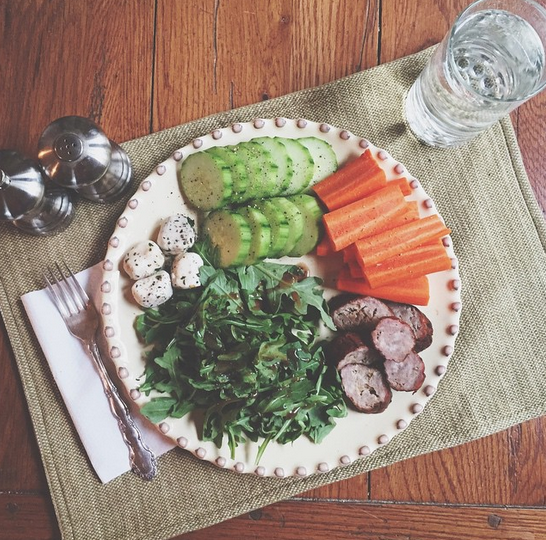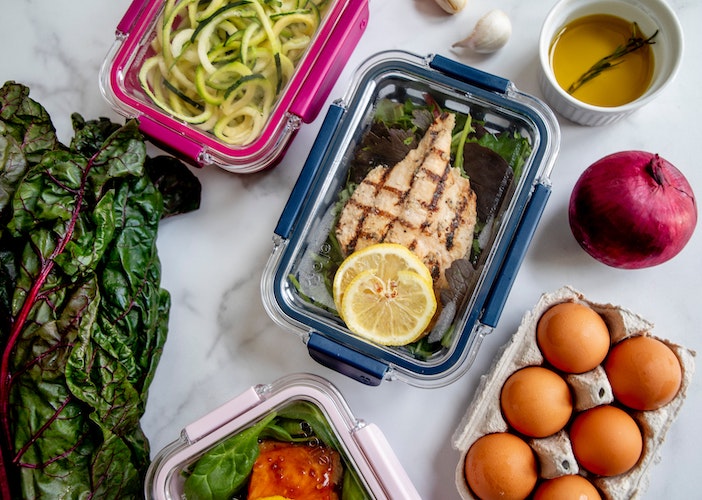 I’ve always kind of loved the grocery store. When I walk through those automatic sliding doors and set my eyes upon the perfectly arranged produce displays, I am a special kind of happy. I realize that is pretty weird, or at least people tell me that it’s pretty weird. But all that time I’ve spent enjoying grocery shopping and perusing the aisles of new grocery stores for fun (which I legitimately have done…), has left me with a few key strategies for saving money while eating well and not spending all of your time cooking.
I’ve always kind of loved the grocery store. When I walk through those automatic sliding doors and set my eyes upon the perfectly arranged produce displays, I am a special kind of happy. I realize that is pretty weird, or at least people tell me that it’s pretty weird. But all that time I’ve spent enjoying grocery shopping and perusing the aisles of new grocery stores for fun (which I legitimately have done…), has left me with a few key strategies for saving money while eating well and not spending all of your time cooking.
A caveat to this is that I’m a vegetarian, which is a cheaper diet to begin with, and also means this post contains absolutely no tips for saving money on meat. (Sorry, not sorry.) And a second caveat is that I truly enjoy cooking and grocery shopping. Even if you hate both of those things, I still think you can find some tips here but you might not appreciate my “grocery shopping is the best” attitude throughout. Also, I try to eat as healthfully as my self-control can manage. Which is to say, pretty healthy 80% of the time, and not at all healthy 20% of the time. Full Confession: I ate four Oreos today.
So without further ado, here are nine tips I have for making the most out of your time and money at the grocery store:
1. Make your cheapest go-to recipes more often.
This is one of the easiest ways to save money at the grocery store. Take a few minutes to think about (or even write down) the recipes you find yourself making or craving the most often. Then figure out roughly how much each of those costs per serving. This can seem tricky but it’s actually much easier than it seems. If you don’t feel comfortable ballparking the costs, spend a few minutes walking around the grocery store you shop at the most. Write down the prices of each ingredient and then do a comparison. You can even use this handy tool if you really want to do some analysis.
For example, if we compare eating oatmeal with brown sugar and cinnamon for breakfast one morning ($0.18) or having eggs and toast and butter ($0.80), there is a clear winner. Replace one of your eggs and toast mornings with oatmeal, and you’ve already saved yourself some money. And if you’ve replaced a Panera bagel with cream cheese with the oatmeal, you’ve really saved yourself some money. It’s easy to do the same with dinner. If you enjoy both pesto pasta (and really…who doesn’t?) and pasta with marinara, the pasta with marinara comes out on top. Basil and pine nuts are expensive (although you can try some cheaper alternatives), so choose the marinara over the pesto one night a week and you’ve saved yourself some cold hard cash.
That’s not to say you should cut out more expensive recipes all together–far from it, you’re still saving a lot of money by eating in instead of eating out. And if making more expensive meals for yourself will keep you from eating out, do that and you’ll still save money. But if you can eat your cheaper go-to meals more often than your more expensive ones, you can cut some unnecessary bucks off your grocery bill nearly effortlessly. Pro-tip: Purchase a budget eating focused cookbook — I swear by Robin Robertson’s Vegan on the Cheap, which costs out each recipe per serving (and they’re so good!). This site is great for that as well, although I can’t vouch for the recipes themselves as I haven’t made anything from the site.
2. Have a plan before you go grocery shopping.
Here’s how I make a plan:
Step 1: I check what’s on sale at my grocery store (see item 3).
Step 2: I pick 2-3 recipes I’m going to make for the week that utilize at least some ingredients that are on sale. If I can, I try to choose my recipes so that some ingredients overlap. That way I need to buy fewer ingredients and I don’t have to get too creative with stray leftovers in the fridge.
Step 3: I check to see what ingredients I already have.
Step 4: I add anything I don’t have to a grocery list, organized by area of the grocery store (i.e. produce, canned goods, dairy, etc.).
Step 5: I consider what ingredients I will have leftover from the recipes I’m making. Does the recipe call for 1 cup of sour cream, but the smallest size in the store is 2 cups? I try to brainstorm how I can use these odds-and-ends, and add anything else I would need for those ‘non-recipe recipes’ to the list as well (I’ll bake potatoes and top with sour cream and broccoli, so I add potatoes and broccoli to the list.)
Step 6: I consider any holes I need to fill–do I have enough food for breakfast? Do I have enough fruits and vegetables for the week?
Of course, some people plan in completely different ways than I do–but I’ve found this makes my grocery shopping trips the most enjoyable, cost-efficient, and flavorful they can be.
3. Check what’s on sale at your grocery store BEFORE you make your grocery list or meal plan for the week.
Shopping the sales is not the same as using coupons, although if your grocery store has an easy online coupon system like mine does, by all means use it. Look at what your grocery store has on sale this week (most stores have ads online), or even just look up what fruits and vegetables are currently in season locally. (This is a great site for finding out what’s in season when.) Plan your meals around those–it’s as simple as that. Food is not only cheaper when it’s in season, it’s also much tastier. An asparagus tart will taste a helluva lot better in the spring/summer than it would in the fall, and grapefruits are meant to be eaten in the winter months. Don’t catch yourself trying to make a recipe with all out-of-season ingredients. Here’s one of my favorite summer recipes–three of the ingredients (basil, mango, and blueberries) are very expensive the rest of the year but affordable and delicious now!
4. Know yourself.
If you know that you will pick out a complicated recipe and buy all the ingredients, only to never make the recipe itself, don’t buy the ingredients. Allow yourself to enjoy browsing cooking blogs and picking out recipes you’d like to try, without committing yourself to doing something you know you’re not going to do and wasting money in the process. If you want to be the kind of person who eats salad for lunch every day but you end up getting hangry at 3pm and heading out for a snack consistently, you’re not the kind of person who can eat a salad for lunch every day. Or you can, but you need to add more fats or protein to it, or pack a substantial afternoon snack. It’s okay to eat more or differently than other people, as long as you know yourself and you’re making the right choices for you. If you can only stand to make recipes that take 20 minutes and your best friend cooks for two hours every night and loves it — that’s okay! You need to know yourself and know your body. There are lots of healthy ways to save money and eat well — for everyone.
5. Save complicated/unfamiliar meals for dining out.
I am well aware that if I made my own pad thai all the time, it would cost much less than it does at my neighborhood Thai restaurant. But it’s not going to taste as good, it would require me to go out and buy a lot of new ingredients, and I wouldn’t be able to use those ingredients for many other recipes. This is a classic example of when you can put your “dining dollars” to good use. Don’t spend money eating food at restaurants you could make better, healthier, and cheaper at home. Spend your money on restaurant food that excites you, is delicious, and that it would be hard to replicate at home. You can read the recipe for a Cobb salad on the menu at a pub and go home and make it in 20 minutes for a fraction of the cost. But that pho you’re eyeing at a new Vietnamese restaurant you’ve been wanting to try? Eat your heart out, my friend! Embrace new flavors and put your money to its most efficient use.
6. Buy versatile ingredients and staples.
This is a tip that’s valid for the grains and legumes in your cupboard and the veggies in your freezer, as well as the bread on your counter and the fruit in the fridge. Stocking up on brown rice, pasta, quinoa, lentils, and any other grain, legume, or bean you enjoy eating is a key to healthy, economical cooking. If you have those staple ingredients, you can add a veggie, protein, and sauce and have a great meal on the table without needing to run to the store. In addition, those kinds of staple items are cheaper when you buy them in larger quantities. If you can plan to head to Trader Joe’s or Whole Foods (where they sell many staples in bulk) before you run out of these items, you’ll save yourself from wasting a lot of money on buying an “emergency” tiny box of quinoa at a grocery store, just because you ran out.
But in addition to keeping these versatile staple ingredients around, you should also consider the versatility of the more perishable items you purchase. I find this idea rings very true when it comes to bread. If I buy rye bread, I can only use it with savory flavors — sandwiches, as an accompaniment to soup, with a fried egg on top, etc. If I buy honey-wheat bread, I can only use it with sweeter flavors–slathered with peanut butter, as french toast, drizzled with honey, etc. But if I buy whole-wheat or multi-grain bread, I can use it for both. I’m maximizing the efficiency of my grocery purchase by choosing the most versatile option. This is also true of vegetables and fruits, both of which should be able to do double-duty as recipe ingredients or snacks on their own. Let’s say you were planning to make a stew one night that required celery. You don’t like to eat celery on its own, but you wouldn’t mind it in the stew. Instead of buying celery, you buy carrots. When you have carrots leftover after making the stew, or if you don’t ever end up making it, you can still eat the carrots as a snack. If you had kept true to the recipe and bought celery, you would be stuck with something that you would ultimately end up throwing out–because for you, it wasn’t versatile enough.
7. Try the store brand first.
We all have our beloved brand favorites — Ore Ida potatoes, Jif peanut butter, Kashi cereal, Kraft mac and cheese. These are beloved for a reason for sure, but have you tried the store brand? For anything I buy with any regularity, I try the store brand first. Cereal, peanut butter, cheese, soy milk, juice, salad dressing, etc. You never know when one of the items you regularly pay a premium for tastes the exact same as the store brand which is $1 less. If you try it and you don’t like it, by all means keep buying your name brand. But at least you will know that you tried the cheaper option and you are choosing the more expensive option, not just buying it out of habit. By the way, I hate store brand peanut butter but I don’t mind store brand soy milk! I’ve paid $1 less for my soy milk ever since. And $2 more for my peanut butter. Worth it.
8. Make what you can yourself.
Cashew butter is insanely easy to make, and so are hummus and granola and lots of other things. If creating your own batch of hummus sounds boring–don’t do it! It won’t be worth the cost savings for you. But if it sounds like it could be fun, and you’re interested in trying out some new flavors, you can save a pretty penny doing it yourself. My favorite thing to make myself is coconut whipped cream. It’s actually probably not cheaper than a tub of Cool Whip but it is SO good, SO easy, and SO much better for you. You can almost eat the whole batch with little guilt. Almost.
9. And finally, focus on meals, not snacks.
I am a snacker — I love all things about snacks. The ritual of sitting down with some popcorn to watch a TV show, pulling out the bag of chips and jar of salsa at the end of a long day, getting a little taste of some great cheese in the late afternoon after “just having a salad” for lunch (I am just not one of those salad for lunch people…). But I find that the more I try to focus on meals instead of snacks, the better off I am, both from a health standpoint and from a pocketbook standpoint. I still do snack, but I’ll snack on things like plums or apples or bell pepper strips — produce that can also be components of other meals. By focusing on making and enjoying complete well-balanced meals, I no longer need to stock my pantry with pretzels or granola bars or those DELICIOUS Trader Joe’s Powerberries (although I definitely still do sometimes). Focusing on meals keeps me feeling full throughout the day, and opens up some room in my wallet for more fresh produce. While I may be spending the same amount of money on these kinds of snacks, at the end of the day I feel like it’s a better way to spend my money.
I’m sure there are tons of ways to shop smarter that I haven’t thought of yet. Leave your own tips and strategies in the comments!
Emily lives in Washington, DC and loves it, but wishes everything cost as little as it does back home in Michigan. She is a social policy researcher and huge fan of craft beer. Follow her on Twitter.



